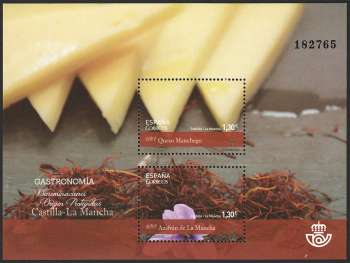GENERAL INFORMATION
Country
Spain
Type
Stamp (Miniature Sheet)
Class
Special Issue
Front Inscription
GASTRONOMÍA
Denominaciones de Origen Protegidas Castilla-La Mancha
Queso Manchego
Azafrán de la Mancha
Denominaciones de Origen Protegidas Castilla-La Mancha
Queso Manchego
Azafrán de la Mancha
Issued Price
2.60 Euro
Issued Date
09/06/2016
Printer
RCM-FNMT (Real Casa de la Moneda - Fábrica Nacional de Moneda y Timbre)
Printing Method
Offset
Quantity Issued
200,000
Gum
Gum
Dimension
133 × 99 mm
Fatal error: Uncaught TypeError: count(): Argument #1 ($value) must be of type Countable|array, bool given in E:\htdocs\exonumi\index\publish\publish_SP.php:376 Stack trace: #0 E:\htdocs\exonumi\_file.php(39): include() #1 E:\htdocs\exonumi\index\publish\publish_template.php(204): include('E:\\htdocs\\exonu...') #2 E:\htdocs\exonumi\_file.php(39): include('E:\\htdocs\\exonu...') #3 E:\htdocs\exonumi\index\publish\publish.php(1093): include('E:\\htdocs\\exonu...') #4 E:\htdocs\exonumi\_file.php(39): include('E:\\htdocs\\exonu...') #5 E:\htdocs\exonumi\index_map.php(421): include('E:\\htdocs\\exonu...') #6 E:\htdocs\exonumi\index.php(24): include_once('E:\\htdocs\\exonu...') #7 {main} thrown in E:\htdocs\exonumi\index\publish\publish_SP.php on line 376
